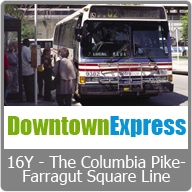Planning and Development
The Washington Metropolitan Area Transit Authority (Metro) is focused on promoting smart development around transit facilities, implementing capacity and service improvements to both Metrorail and Metrobus, and advancing transit expansion projects that are best aligned with Metro's vision and goals.
For questions or more information about planning studies, email us.
Joint Development Opportunities
Metro has a very active public/private Joint Development Program. Updated Joint Development Policies and Guidelines ![]() (1.91 MB) were approved in 2008. For more information, see our Joint Development Opportunities page.
(1.91 MB) were approved in 2008. For more information, see our Joint Development Opportunities page.
Adjacent Construction Program
The Metro Office of Joint Development and Adjacent Construction (JDAC) reviews and approves joint development projects and those projects adjacent to Metro's Metrorail and Metrobus property, facilities, and operations. To view the Metro Adjacent Construction Project Manual, procedural documents, and permitting forms, visit the Adjacent Construction Program page.
Capital Needs Inventory
Metro developed the FY 2011 - FY 2020 Capital Needs Inventory to address its performance needs (investments to maintain existing system in a "State of Good Repair" and improve the safety and reliability of service), demand needs (investments to expand system capacity to meet growing demand), and customer needs (investments to improve infrastructure, service, and business practices to provide more cost-effective, quality service). The $11.3 Billion Capital Needs Inventory was presented to the Board on September 25, 2008. See the Capital Needs Board Presentation ![]() (2.95 MB).
(2.95 MB).
The Capital Needs Inventory was based on outreach to each department, life-cycle costs, current conditions, and future demand. The purpose of this agency-wide, "bottom-up" inventory of Metro's capital needs is to serve as the foundation for the next capital funding arrangement. The Capital Needs Inventory is the first step in a strategic capital planning process to be implemented at Metro. Next, Metro will prioritize the programs listed in the Capital Needs Inventory based on agency goals and jurisdictional input. Below are links to FY 2011 - FY 2020 Capital Needs Inventory Summary Report and capital program templates grouped by focus area and asset category. Each template contains a program description, justification, budget, and linkage to agency goals.
FY 2011 - FY 2020 Capital Needs Inventory Summary Report ![]()
Performance Focus Needs
- Vehicles

- Systems & Technology

- Maintenance & Other Facilities

- Track & Structures

- Passenger Facilities

Demand Focus Needs
Customer Focus Needs
Complete FY 2011 - FY 2020 Capital Needs Inventory templates ![]() (4.71 MB)
(4.71 MB)
Metrobus Plans and Projects
Metro is defining and advancing a new vision for a family of bus services throughout the region including service integration, operations improvements, running way improvements, bus stop facilities, and customer information.
- 30 Line Study
- Southeastern Bus Garage Replacement
- Metrobus Fleet Management Plan (2007)
 (2.32 MB)
(2.32 MB) - Metrobus Network Evaluation and Fleet Needs (2007)

- Regional Bus Study (2003)
 (3.47 MB)
(3.47 MB) - Regional Bus Study - Phase 2 Implementation Plans (2004)
 (11.38 MB)
(11.38 MB) - DC Neighborhood Circulation Study
- Service Evaluation Study
Metrorail Plans and Projects
Thirty years after service first began on the Washington Metrorail, the system has become an integral part of the region's transportation network. Metrorail ridership has increased over the years as the system has expanded and the region has developed. Continued growth in ridership requires expansion of station facilities to handle passenger flow within the station, as well as expansion of facilities to support auto, bus, and pedestrian access to stations.
- Metrorail Station Access & Capacity Study (2008)
 (3.64 MB) and Report Appendices
(3.64 MB) and Report Appendices  (1.26 MB)
(1.26 MB) - Metrorail Fleet Management Plan (2007)
 (3.38 MB)
(3.38 MB) - Farragut North and Farragut West Pedestrian Passageway Tunnel Study

- Metro Center/Gallery Place Pedestrian Passageway Tunnel Study

- Core Capacity Study (2002)

- Final Environmental Impact Statement (August 1975)
 (112.67 MB)
(112.67 MB)
Transit Expansion Plans and Projects
Metro and its regional partners are looking at new ways to expand service in underserved communities and expand and improve service in heavily used corridors. The following projects aim to identify the more efficient ways to provide service in areas with current or anticipated future high demand for transit service.
- Transit Service Expansion Plan (1999)
- Dulles Metrorail Extension
- Columbia Pike Alternatives Analysis
- Crystal City / Potomac Yard Transit
- DC Transit Alternatives Analysis
- Purple Line / Bi-County Transitway
Station Area Plans and Access Improvement Studies
Metro is committed to increasing and improving access to its Metrorail stations. This includes facilitating easy bicycle, pedestrian, and vehicular access to station areas, planning for additional entrances to rail stations, and working with local jurisdictions to encourage and enable quality development opportunities around our stations.
- Station Site and Access Planning Manual
 (5.79 MB)
(5.79 MB) - Bethesda Station/Transitway Access Demand Analysis
 (10.24 MB)
(10.24 MB) - East Falls Church Station Access Study
 (3.11 MB)
(3.11 MB) - Rockville Station Access Improvement Study
 (19.67 MB)
(19.67 MB) - Minnesota Avenue Station Access Improvement Study
 (15.56 MB)
(15.56 MB) - Crystal City Station Access Study
 (2.90 MB)
(2.90 MB) - Rosslyn New Station Entrance Study
 (1.42 MB)
(1.42 MB) - Court House Station Access Improvement Study
 (55.42 MB)
(55.42 MB) - Foggy Bottom Station Second Entrance Demand Analysis
 (13.79 MB)
(13.79 MB) - Pentagon City Metro Station Enhancements
 (8.79 MB)
(8.79 MB) - Stadium Armory Station Area Planning Study
 (4.11 MB)
(4.11 MB) - Rosslyn Station Access Improvement Study
 (4.51 MB)
(4.51 MB)










